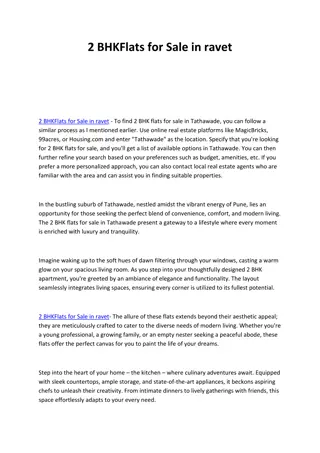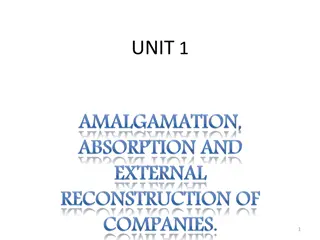
Amalgamation of Partnership Firms Explained
Learn about the meaning, forms, objectives, and accounting treatment of amalgamation of partnership firms. Understand the process of merging business units, creating new firms, and handling assets and liabilities. Explore the benefits and objectives of amalgamation to strengthen business positions and minimize competition.
Download Presentation

Please find below an Image/Link to download the presentation.
The content on the website is provided AS IS for your information and personal use only. It may not be sold, licensed, or shared on other websites without obtaining consent from the author. If you encounter any issues during the download, it is possible that the publisher has removed the file from their server.
You are allowed to download the files provided on this website for personal or commercial use, subject to the condition that they are used lawfully. All files are the property of their respective owners.
The content on the website is provided AS IS for your information and personal use only. It may not be sold, licensed, or shared on other websites without obtaining consent from the author.
E N D
Presentation Transcript
Ms. Meenakshi Assistant Professor Commerce Department Kanya Mahavidyalaya Kharkhoda
Meaning of Amalgamation Amalgamation means to merge or to combine two or more business units carrying on same type of business and form a new business unit. Amalgamation of partnership firms means merger of two or more partnership firms with one another and form a new partnership firm. Example: A & B firm + X & Y firm= A,B,X & Y firm 0r if A & B firm is taken over by X & Y firm then , after amalgamation onlyX & Y firm will exist.
Forms of Amalgamation of partnership firms Amalgamation may be formed with any of the following ways: 1. Merging of two or more existing sole proprietors into each anotherand form a new partnership firm. 2. Merging one existing partnership firm with one existing sole proprietor and form a new partnership firm. 3. Absorbing one existing partnership firm by another existing partnership firm. 4. Merging two or more existing partnership firms with oneanotherand form a new partnership firm.
Objectives of amalgamation of partnership firms: To avoid cut-throatcompetition. To minimize the commonexpenses of business. To getadvantageof large scale business. To strengthen the capital position. To getadvantageof expertise of different peopleetc.
Accounting Treatment of amalgamation of firms Amalgamation of partnership firms includes Opening the books of amalgamating firms/new firm Closing the books of amalgamated firms/old firms
Closing the books of old firms Revaluation account is prepared. Entry for raising goodwill is passed. Assets and liabilities not taken over by the new firm are transferred to the partners capital account. New firm s account is debited with the value of assets and assets are credited. New firm s account is credited with the value of liabilities and liabilities are debited. or New firm s account is debited with the difference between the value of assets and liabilities.
Journal Entries in the books of old firms (closing entries) Revaluation of assets and liabilities: Assets A/c . dr. 1. To Revaluation A/c (for increase in value of assets ) Revaluation A/c . dr. To Assets A/c (for decrease in value of assets) Revaluation A/c . dr. To liabilities A/c (for increase in value of liabilities) Liabilities A/c . dr. To Revaluation A/c (For decrease in value of liabilities)
Continue To partners capital A/c ( for distribution of profit on revaluation among partners) or Partners capital A/c .dr. To Revaluation A/c ( for distribution of loss on revaluation among partners) Revaluation A/c . dr. 2. Assets and Liabilities not taken over by the new firm Partner s capital A/c .dr. To Assets A/c (Assets taken over by partners) Liabilities A/c .dr. To Partner s A/c (Liabilities paid by /taken over by partners)
Continue 3. Division of accumulated profits /losses/Reserves. Profit & Loss A/c dr. Reserves A/c ..dr. To Partners capital A/c (For distribution of accumulated profits and reserves) Partners capital A/c dr. To Profit & Loss A/c ( for distribution of loss among partners) 4. For raising/creating goodwill in the books of the firm Goodwill A/c dr. To partners capital A/c ( goodwill is to be transferred in old profit sharing ratio)
Continue.. 5. Transfer of Assets and liabilities to the new firm. New firm s A/c . dr. To Sundry Assets A/c ( for transfer of assets to the new firm) Sundry Liabilities A/c .dr. To new firm s A/c (for transfer of liabilities to the new firm) or Sundry Liabilities A/c dr. New firm s A/c ..dr. ( with the balancing figure) To Sundry Assets A/c (Transfer of Assets and liabilities to the new firm.)
Continue 6. Final closing of Capital Accounts Partners capital A/c . dr. To new firm s A/c (for closing of partners capital accounts) Ledger Accounts to be maintained in the books of old firms: Revaluation A/c 2. Partners capital A/c 3. New firm s A/c 4. Goodwill A/c 1.
Journal Entries in the books of new firm/ opening entries 1. Assets, liabilities and capitals of the partners of the old firm taken over by new firm Sundry Assets A/c ..dr. ( revised values) To Sundry liabilities (revised values) To partners capital A/c ( for assets, liabilities and capitals of the partners of the old firm taken over by new firm) Point to be noted: Above mentioned entry is passed separately for each firm Different assets and liabilities taken over by the new firm are recorded separately by their names.
Continue. 2. For Adjustment of Goodwill : The goodwill transferred from the old firm to the new firm may be maintained as it is or may be written off or may be reduced by the new firm. If goodwill written off or reduced , the entry will be as follows: All partners capital A/c .. dr. (new ratio) To Goodwill A/c ( for goodwill written off )
Ledger Accounts to be maintained by new firm Assets A/c Liabilities A/c Partners capital A/c Balance sheet
Sale of Partnership firm to a company Sometimes, a partnership firm sells its business to an existing company or converts itself into a company . The main reason for conversion is that in case of partnership, the liability of partners is unlimited whereas in case of companies the liability is limited. Sale price of the firm is fixed by mutual understanding. The firm being sold is dissolved and the partners receive the shares of the company to whom the firm is being sold and thus they become the shareholders of the company.
Accounting records in the books of the firm Realisation A/c 1Transfer all recorded assets and liabilities(whether or not taken over by the purchasing company) to the Realization account, except cash and bank balance if not taken over by the purchasing company. Realization A/C . Dr. To sundry assets (For transferring recorded assets) Sundry liabilities A/C .. Dr. To Realization A/C (For transferring recorded liabilities) Purchasing company A/C . Dr. To Realization A/C (For purchase price due)
Continue 2. If, there remain any assets(whether or not recorded) not taken over by the purchasing company, it may be sold, or may be taken by one of the partners or may be shared among the partners. I. On sale of assets Bank A/C . Dr. To realization A/c (sale of assets not taken over by the purchasing company) II. On division of assets among partners Partners' capital A/C(capital ratio) Dr. To realization A/C ( for sharing assets among the partners)
continue 3.The liabilities (whether or not recorded) by the purchasing company may be discharged or may be assumed by any one of the partners, or must be shared by the partners in their capital ratio. I. If liability is paid by purchasing company Realization A/C .............Dr. To Bank A/C (For discharging liability by purchasing company) II. If such liability has to be assumed by all partners Realization A/C................Dr. To Partners' capital A/C (For distribution of liabilities among partners)
Continue. 4.When the realization expenses is paid, Realization account is debited. Realization A/C.............Dr. To Bank (For payment of realization expenses) 5. Close the realization account by transferring the balance (profit or loss) to the capital of the partners in profit sharing ratio. Realization A/C..............Dr. To Partners' capital A/C (For profit on realization account) or Partners' capital A/C............Dr. To realization A/C (For loss on realization account)
Continue 6. On the receipt of purchase consideration (price), cash/bank account, equity shares in purchasing company or preference shares in purchasing company at their issue prices are debited and purchasing company's account is credited. Cash/bank A/C....................................Dr. Equity share in purchasing Co...........Dr. Preference share in purchasing Co....Dr. Debentures share in purchasing Co...Dr. To purchasing Co. (For the receipt of purchase price)
Continue 7.Transfer all accumulated reserves/profits/losses to the capital accounts of partners in profit sharing ratio. Reserve A/C.................Dr. Profit and loss A/C.......Dr. To partners' capital A/C (For accumulated reserves, profits) or Partners' capital A/C.............Dr. To profit and loss A/C (For accumulated losses) 8.Transfer the current account, if any, to the capital accounts of the partners. Partners' current Account................Dr. To partners' capital Account (For transferring current account to the capital account) 9.Pay off the partner's loan if any. Partner's loan A/C ..............Dr. To bank A/C (For the payment of partner's loan )
Continue 10. Make final settlement by paying off balances in capital accounts. In the absence of an agreement as to the division of shares (from purchasing company) among partners, such shares are distributed in the ratio of their final claims (i.e. in the ratio of capitals after all the adjustments). Vendor s/Partners' capital A/C ...........Dr. To equity shares in purchasing Co. To preference shares in purchasing Co. To bank A/C (For final settlement)
Continue Entries in the books of purchasing company Assets Account...........................Dr. Goodwill Account........................Dr. (balancing figure) To liabilities To share capital To share premium (Being assets and liabilities taken over) Note: In case debit higher than credit, capital reserve is credited with the difference.






















